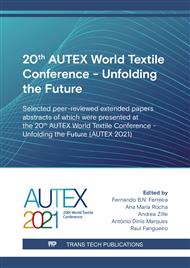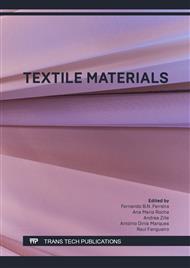[1]
J. Camillo, What's New With UV-Cure Adhesives, Assembly 60 (2017) 34-37.
Google Scholar
[2]
A.D. Alobaidani, D. Furniss, M.S. Johnson, Optimization and spectroscopic experiments of cationic epoxy formulations for the application of photocuring of deep resin mediums using side emitting optical fibres, Proceedings, International Committee on Composite Materials (ICCM) 17, Edinburgh, Scotland, (2009).
Google Scholar
[3]
S. Wellmann, J.d, N. Nuyts, Lichthärtung auch im Schattenbereich, Adhäsion: Kleben & Dichten 50 (2006) 29-32.
DOI: 10.1007/bf03243656
Google Scholar
[4]
R. Søndergaard, M. Hösel, D. Angmo, T.T. Larsen-Olsen, F.C. Krebs, Roll-to-roll fabrication of polymer solar cells, Mater Today 15 (2012) 36-49.
DOI: 10.1016/s1369-7021(12)70019-6
Google Scholar
[5]
C.-H. Park, S.-J. Lee, T.-H. Lee, H.-J. Kim, Characterization of an acrylic polymer under hygrothermal aging as an optically clear adhesive for touch screen panels, Int J Adhes Adhes 63 (2015) 137-144.
DOI: 10.1016/j.ijadhadh.2015.08.012
Google Scholar
[6]
R. Seewald, J. Kallweit, J. Weiland, A. Schiebahn, T. Gries, U. Reisgen, Use of UV-Curing Adhesive Systems on Non-transparent Joining Parts by Using Sidelight Activated Polymer Optical Fibres, in: L. F. M. da Silva, R. D. Adams, C. Sato, K. Dilger (Eds.), Industrial Applications of Adhesives, Springer Singapore, Singapore, 2021, p.1–14.
DOI: 10.1007/978-981-15-6767-4_1
Google Scholar
[7]
A. Choudhary, E. Prasad, UV Curable Resin Market by Resin Type (Acrylated Epoxies, Acrylated Polyesters, Acrylated Urethanes, Acrylated Silicones, and Others) and Application (Coating, Packaging, Printing, Adhesives & Sealants, and Others): Global Opportunity Analysis and Industry Forecast, 2019–2026, first ed., Allied Market Research, Portland, (2019).
DOI: 10.1016/j.eurpolymj.2019.109320
Google Scholar
[8]
C.-A. Bunge, M. Beckers, B. Lustermann, Basic principles of optical fibres, in: C.-A. Bunge, T. Gries, M. Beckers (Eds.), Polymer Optical Fibres: Fibre Types, Materials, Fabrication, Characterisation and Applications, Elsevier, Amsterdam, 2017, p.47–118.
DOI: 10.1016/b978-0-08-100039-7.00003-8
Google Scholar
[9]
S. Kulkarni, Application of polymer optical fibers, in: M. A. Esteso, A. C. Faria Ribeiro, S. C. George, A. R. Abraham, A. K. Haghi (Eds.), Oprical and molecular physics: Theoretical principles and experimental methods, Apple Academic Press Inc., Palm Bay, 2021, pp.153-174.
DOI: 10.1201/9781003150053
Google Scholar
[10]
J. Zubia, J. Arrue, Plastic Optical Fibers: An Introduction to Their Technological Processes and Applications, Opt. Fiber Technol. 7 (2001) 101–140.
DOI: 10.1006/ofte.2000.0355
Google Scholar
[11]
H. Pan, Introduction: Why Plastic Optical Fibers, in: M. M. Werneck, R. C. da Silva Barros Allil (Eds.), Plastic Optical Fiber Sensors: Science, Technology and Applications, CRC Press, Boca Raton, 2019, pp.1-20.
DOI: 10.1201/b22357
Google Scholar
[12]
J. Spigulis, Side-Emitting Fibers Brighten Our World, Opt. Photon. News 16 (2005) 34–39.
DOI: 10.1364/opn.16.10.000034
Google Scholar
[13]
V. Koncar, Optical Fiber Fabric Displays, Opt. Photon. News 16 (2005) 40–44.
Google Scholar
[14]
J. Kallweit, M. Pätzel, F. Pursche, J. Jabban, M. Morobeid, T. Gries, An Overview on Methods for Producing Side-Emitting Polymer Optical Fibers. Textiles 1 (2021) 337-361.
DOI: 10.3390/textiles1020017
Google Scholar
[15]
G. Habenicht, Kleben: Grundlagen, Technologien, Anwendungen, 6th ed., Springer-Verlag Berlin Heidelberg, (2009).
Google Scholar
[16]
J. Wang, B. Huang, B. Yang, Effect of weave structure on the side-emitting properties of polymer optical fiber jacquard fabrics, Text. Res. J. 83 (2013), 1170–1180.
DOI: 10.1177/0040517512471751
Google Scholar
[17]
R. H. Myers, D. C. Montgomery, C. M. G. Anderson-Cook, Response Surface Methodology: Process and Product Optimization Using Designed Experiments, 4th ed., John Wiley & Sons, Hoboken, (2016).
Google Scholar
[18]
DELO Industrie Klebstoffe GmbH & Co. KGaA, Technical Datasheet: DELO® PHOTOBOND® FB4175, as of 27.07.(2020).
Google Scholar
[19]
J. Shen, C. Chui, X. Tao, Luminous fabric devices for wearable low-level light therapy, Biomed. Opt. Express 4 (2013), 2925–2937.
DOI: 10.1364/boe.4.002925
Google Scholar



